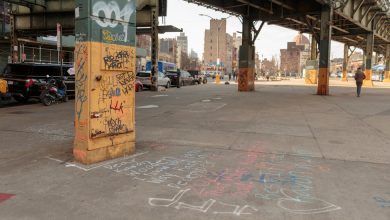How Did a Two-Time Killer Get Out to Be Charged Again at Age 83?

The person before the parole panel in June 2019 was tall and slim, in far better shape than 81 years of life might have suggested. Mild and polite, the supplicant seemed nothing like the murderer who had spent decades in prison, first for shooting a girlfriend dead in 1963, and then for stabbing another in 1985, stuffing her corpse into a bag and leaving it in Central Park.
“I’m no longer that person,” the inmate told the parole board commissioners. Despite misgivings, they would rule in favor of release.
Two and a half years after leaving Cayuga Correctional Facility, Marceline Harvey was accused again, charged with killing Susan Leyden, 68. Parts of Ms. Leyden’s body were found in March inside a shopping cart in East New York, stuffed in a bag. In Ms. Harvey’s apartment, investigators found a bloody mop, a tub full of towels and a box for an electric saw.
For seven decades leading up to her latest arrest, Ms. Harvey navigated New York’s intricate criminal justice bureaucracy: the country’s largest police apparatus, the state’s overlapping welfare agencies, its prisons and the officials charged with deciding who remains in them. She confronted the system in some moments, manipulated it in others. Behind her was a trail of crimes so grisly that for decades, parole officials refused to let her out.
Now Ms. Harvey has pleaded not guilty to murder. Ms. Harvey’s lawyer at the Brooklyn Public Defenders’ office declined to comment on her case. Ms. Harvey, who is being held at Rikers, could not be reached for comment; she declined an interview request.
Decades worth of police documents and court records detail the life of Ms. Harvey, a transgender woman who transitioned at some point after her release from prison. Central to her tale are more than three decades of parole board minutes obtained through the state’s Freedom of Information Law. In them, she insists that authorities exaggerated evidence, changes stories about crimes she admitted and veers between contrition and blaming those she killed.
The records include several examples of her harassing or attacking women throughout her life. She was accused of attempted rape at 14; the victim was an 8-year-old girl. Ms. Harvey, who by her own account struggled with her mental health, said she had to choke down rage when women challenged her manliness before she transitioned — making fun of her soft voice, for example.
A homeless shelter worker and people close to Ms. Leyden questioned whether, despite her gender identity, Ms. Harvey should have been placed in a homeless shelter for women, given her history of attacking and murdering them. Speaking from Rikers to The New York Post, Ms. Harvey referred to herself as having two personas: one, a violent male named Harvey Marcelin — the name she used for most of her life and is included in court records — and the other, a soft-spoken woman named Marceline Harvey.
But transgender people are far more likely to become victims of violence, not perpetrators, and data from the National Center for Transgender Equality suggests more than half of transgender people who stay in shelters encounter harassment.
And the crucial question surrounding Ms. Harvey’s case is less complicated: How was someone who had killed twice before allowed the chance to kill again?
“Anger doesn’t dissolve at 84,” said Dr. Katherine Ramsland, a professor of forensic psychology at DeSales University in Pennsylvania. “It wouldn’t surprise me that a person who killed earlier — even 50, 60 years earlier — out of anger, would feel the same compulsion.”
Even so, a spokesman for the New York Department of Corrections and Community Supervision said Ms. Harvey met the criteria for release. Ms. Harvey had completed therapy and coursework, and had letters of support from organizations that work with released offenders, the parole records show. The prison system had deemed her unlikely to commit a violent offense.
Krystal Rodriguez, policy director for the Data Collaborative for Justice at John Jay College of Criminal Justice, said the crime of which Ms. Harvey is accused was so bizarre that parole board officials would be unlikely to foresee it.
“Someone committing such a tragic and violent crime at this age is so incredibly rare that it would be very difficult for anyone reviewing this case to even consider,” Ms. Rodriguez said.
A Propensity for Violence

Marceline Harvey at the 75th Precinct station after her arrest in March.Credit…Lloyd Mitchell
Born in 1938, Ms. Harvey spent her youth in New York, the child of a single mother. Even as a teenager, she displayed a propensity for violence, particularly toward women, and had a complicated gender identity. According to court records and parole board minutes, Ms. Harvey was treated at Catholic Charities, which paired clergy and laypeople with troubled children, after the attempted rape at 14.
As a young adult, Ms. Harvey — described then as a tall, slender man — lived with her mother and earned $75 a week operating copy machines. She had a girlfriend, Jacqueline Bonds, but her life was chaotic: Ms. Harvey drank often, took cocaine, regularly assaulted Ms. Bonds and was in and out of psychiatric care.
In early 1963, Ms. Harvey was again accused of rape, this time as a 24-year-old. (The allegations are referred to by a parole official in a hearing minutes, which offer no further details.)
The accusation set off a spasm of violence: That April, Ms. Harvey killed Ms. Bonds, who had been scheduled to appear before a grand jury considering the case. Ms. Harvey shot her point blank in their crowded Manhattan apartment, chased her as she staggered through the kitchen and living room, and shot her twice more before she collapsed, according to board minutes and a police report.
She was found guilty of first-degree murder and sentenced to life.
During two decades behind bars, she repeatedly appealed her conviction in state and federal courts, and tried to persuade the parole board to free her. Skeptical officials as far back as 1984 cited her aggression toward women. Even in prison, one noted, Ms. Harvey had sent inappropriate letters to candy-striper hospital volunteers.
“That is all in the past, and when I became aware that this pattern was creating, I cut it loose,” Ms. Harvey said.
Weeks later, the board freed Ms. Harvey and she returned to New York.
Shopping Carts and Bloody Garbage Bags
In the early morning hours of Oct. 30, 1985, Roberto Romano was in the lobby of the Cambridge Residence Hotel in Harlem where he lived. He was “smoking reefer,” as he later told police officers, when the tenant of room 602 passed, pushing a shopping cart that held a garbage bag.
“The bag ripped on the first step and blood came out,” Mr. Romano told the police, according to investigative reports.
Hours later, a man walking on Manhattan’s Upper West Side saw a dark plastic bag at the entrance to Central Park at 106th Street, dripping blood. He tore it open, revealing a pair of bound legs.
The victim, identified as Ana Laura Sierra in police records, had been stabbed repeatedly, tied up with a rope, and wrapped in plastic. At 29, she had a heroin habit, according to parole board reports, and several prostitution arrests. Police investigators noticed a pattern: She frequented certain addresses, including room 602 at the Cambridge Residence Hotel.
The address belonged to Ms. Harvey.
At the time, Ms. Harvey was unmoored. She had no stable job, was caught up in street life and wanted to be a pimp, she later told parole officials. Ms. Harvey and Ms. Sierra occasionally lived together.
“She was very fiery and provocative,” Ms. Harvey later told parole officials. Ms. Sierra, she said, brought “johns and tricks to the apartment,” and sold Ms. Harvey’s flute for drugs.
Court records suggest Ms. Sierra was stabbed over 30 times, but Ms. Harvey disputed that in her parole board meetings, according to the transcripts. “Some of those were puncture wounds from rats and squirrels,” Ms. Harvey said, noting the body had sat in the park for hours.
Charged with first-degree murder, Ms. Harvey struck a plea bargain with the Manhattan district attorney’s office for first-degree manslaughter and was returned to prison in 1986.
For 35 years and across 15 hearings, parole officials denied Ms. Harvey freedom. But in June 2019, as she entered her ninth decade, she appeared by video before a two-commissioner panel, Otis Cruse and Joseph Crangle.
Mr. Cruse — a former parole officer who joined the board in 2015 — noted Ms. Harvey’s lengthy history of wrongdoing. Ms. Harvey said she had no family to guide her, and that drug and alcohol abuse contributed.
“Many of those who we speak to lack the guidance that they wish they have had in their youth,” Mr. Cruse said, “but very few of them have replicated a criminal history that’s as graphic as yours has been.”
Still, the commissioners noted that internal assessments indicated a low risk for felony violence or arrest.
“I give you my word,” Ms. Harvey told the board members. “I will never reoffend.”
They approved her release.
Mr. Crangle did not respond to a request for comment; Mr. Cruse deferred to the Department of Corrections. Asked whether the commissioners stood by their decision, Thomas Mailey, a spokesman for the Department of Corrections and Community Supervision, said the transcripts speak for themselves.
On Aug. 7, 2019, Ms. Harvey left prison and reported to her parole officer.
‘Love Personified’
That December, an update popped up on a Facebook page belonging to a Marceline Harvey. It had the caption “Love personified.” It was a picture of Susan Leyden.
Born in 1953, Ms. Leyden had spent most of her life in northern New Jersey. A divorced mother of one daughter, she had run her own jewelry business for years, according to one person close to her.
But facing a downturn, Ms. Leyden decided around a decade ago to relocate to the city, looking to live closer to friends and move around more easily with public transit. It was an affirmative step after a lifetime of loss — her father, two brothers and sister had died, and her marriage had unraveled. She first lived in Queens, and later moved to Brooklyn, where she landed in a supportive housing community for seniors in Fort Greene
It is unclear where her path first crossed Ms. Harvey’s, but at the time Ms. Harvey posted about Ms. Leyden, she was seeking her own placement in city shelters. Immediately after her 2019 release, she sought housing in the Bronx.
Ms. Harvey “presented as a mild spoken, very tall Black man,” said Anne Brennan, the nurse who ran the intake. “I said, ‘Well, why are you in the women’s shelter?’”
Ms. Brennan said she told Ms. Harvey that placing her in a women’s shelter seemed like a bad idea, given her history of killing women. Despite her objections, Ms. Brennan said her supervisors allowed Ms. Harvey entry.
“Apparently his feelings and identity were far more important than all the other women that were terrified of him,” she said.
Julia Savel, a spokeswoman for the city’s Department of Social Services, said rules were followed.
“Our policy — in accordance with the law — is to place individuals in shelters based on their reported gender identity,” she said. “Being homeless or transgender does not make you inherently violent and are not connected to the crime that was committed.”
Though Ms. Harvey continued to post about Ms. Leyden on social media pages, Ms. Leyden’s friends never knew of Ms. Harvey, and Ms. Leyden never discussed her.
On Feb. 27, according to the police, video showed Ms. Leyden entering Ms. Harvey’s building in East New York.
On March 3 — two and a half years after Ms. Harvey posted the first photo of Ms. Leyden — the New York Police Department got a grisly 911 call: There was a shopping cart outside a pawnshop in a mostly industrial section of East New York. Inside, a bag contained a woman’s torso. It was Ms. Leyden’s.





